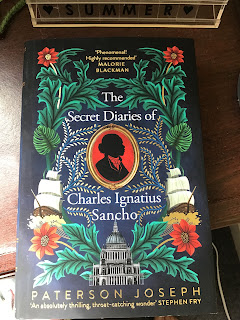Bradford Lit Fest: Never Forget Where You’re Coming From
This time last week, I was at the joy that is Bradford Literature Festival. My whole town taken over by all things book-related!
I went to three completely different talks, two of which I had bought and read the books for in advance. (The other one I will probably buy when it comes out in paperback). They were:
- The Secret Diaries of Charles Ignatius Sancho by Paterson Joseph
- Painted People: Humanity in 21 Tattoos by Matt Lodder
- Among the Eunuchs: A Muslim Transgender Journey by Leyla Jagiella
Three completely different subjects. But what they had in common was that they were all about people on the fringes of society’s so-called norms: Black Britons in the Georgian era; people who have decorated their own skin; traditional third genders in India and Pakistan, along with transgender Muslims.
I’m by nature a curious person, who is drawn to anything different to me. So I’m keen to learn about and include these histories. But it seems that society in general is much less interested, and inclined to forget. This leads to something described in the third talk as “Memory Mutation”. We recall our history as different from what the records tell us. We imagine it to have been fixed in an ages-long changelessness, which is only now being upended, causing us all to panic.
It was interesting that this idea of Memory Mutation came up in all three talks. Paterson Joseph began his presentation by saying he was in his 30s before he knew there were Black people in Britain before the Windrush. In fact, he had been told by casting directors that, no, sorry, but he couldn’t play that part in a historical drama because, “There were no Black people in Britain then.” That simply isn’t true. Actually, there were more Black Georgians than Black Victorians. Which is not to say there were none of the latter. I’ve seen them in drawings of old Bradford street characters. I’ve also seen a Black man in old family photos from the 1920s.
In the talk about tattoos, we were showed -to me - surprising photographs of women and men from the late 19th and early 20th centuries sporting tattoos. Not just sailors, criminals and circus people, but upper class ladies and gentlemen. Why do we not remember this? We were also shown evidence that Britons knew about the use of tattooing by indigenous peoples long before Captain Cook set sail. In fact, a picture showing a tattooed person hung in the Royal Society at the very time of his sailing.
Why is it important that we remember our history correctly? Leyla Jagiella’s book addresses that very question. She was told she could not be Muslim and transgender. But in India and Pakistan she discovered the traditional third genders (hijras and khwajasaras) had been an accepted, and even sacred, part of Muslim community for centuries, tracing their heritage back to the court eunuchs of the Mughal Empire. Likewise, the dominant, conservative theology of Islam (and indeed Christianity) today does not reflect the way saints and scholars of the past saw things. Their insights can seem surprisingly “liberal” to modern ears, even when it comes from people who were considered pretty orthodox in their time.
I’ve written before about the dangers of nostopia. The problem with that is, one person’s Utopia is another person’s Hell. Our world’s past did contain Black Britons and tattooed White people and third-gender Muslims. Not to mention a whole range of other people whose stories I have yet to hear.
The takeaway from this is: stay curious. It makes you more empathic.






Comments
Post a Comment